The landscape of North Dakota before farming was dominated by prairie. The prairies thrived for thousands of years and consisted of grasses and broadleaf plants that deconstructed sediment minerals, releasing nutrients they needed, such as phosphorus, potassium and zinc, and tending to conserve and recycle them close to the soil surface.
The prairie was grazed by millions of animals who ate the top of the grasses and forbs but generally did not graze to the soil. The surface soil was very dark, with organic matter content commonly at least 8 percent. The organic matter and the aggregation of soil particles held the soil together, making it highly resistant to wind erosion.
When the first farmer-settlers came to North Dakota, the environment was foreign to many of them, with extremely cold winters and windy conditions. Many had little money to begin their prairie adventure.
Fortunately, the land was strewn with millions of pounds of buffalo bones. Settlers would drive into the prairies on their own land and still unclaimed land in the 1880s through almost 1920, pick up buffalo bones and deliver them to the nearest collection depot and sell them (Photos 1 and 2).
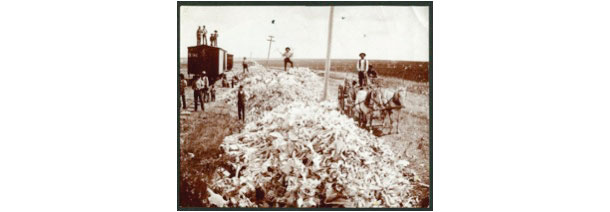
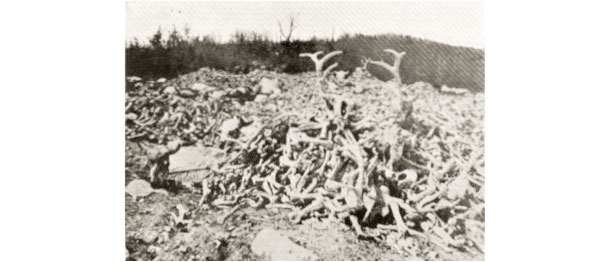
The nitrogen (N), phosphorus (P) and potassium (K) analysis of bones is about 3-15-0. The records of bone tonnage shipped from North Dakota were destroyed in a Northern Pacific Railroad fire years ago, but an estimate can be made from Kansas shipments from the southern herd remains.
Kansas records estimate about 3.2 million pounds of bones shipped East to be used by industry and in fertilizers. Assuming similar tonnage from North Dakota, more than 400,000 tons of P2O5, contained in bones, equal to about two years of P application at today’s present high historic fertilizer application rates, was shipped East.
The farmer-settlers who came to North Dakota in search of land for a better life came from the eastern U.S., Germany, Scandinavia, Russia, eastern Europe and many other places around the globe. A strong wind in their homelands may have been about 10 miles per hour.
To farm in the early 1900s, one needed the new John Deere steel plow, sturdy draft animals and a constitution of hard work. North Dakota was not plowed all at once. It took time to settle all of the land, but by 1920, nearly all the land was plowed.
When the land was first seeded, wheat yields were high even by today’s standards. Average wheat yields in 1885 were about 25 bushels per acre. Some farms achieved as high as 70 bushels per acre. Yields began to seriously decrease by the late 1920s. Part of the reason for the decline was the loss of nitrogen from the system by exposing soil organic matter to oxygen, which increased the rate of mineralization and organic matter decline.
The other reason was wind erosion. The early reports of wind and soil loss did not begin in the period we call the “Dust Bowl,” but much earlier. As soon as the prairie was plowed, the soil started to blow away (Photo 3). Winds of greater than 40 miles per hour were common.
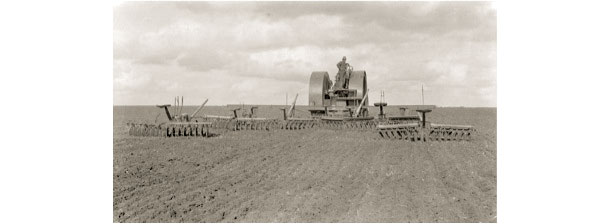
Topsoil loss began to become serious beginning about 1930. The climate turned much drier (Photo 4).

In some years, the fields were almost bare for months. Dust storms lasted for days. Animals died because their lungs filled with dust. People became sick and came down with “dust pneumonia.” The movement of soil from the plains was astounding (Photos 5 and 6). The USDA discovered that soils in the Great Plains were extremely erodible.

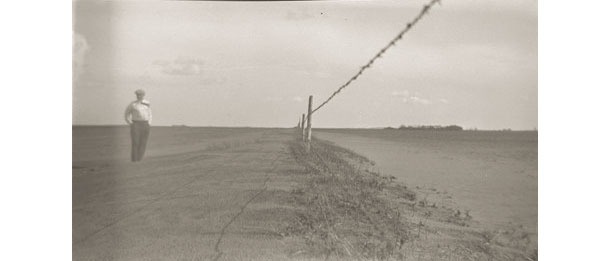
A 1933 report to the secretary of agriculture estimated North Dakota topsoil losses had reduced crop productivity between 15 and 25 percent. When the soil had been fully stripped of topsoil, the fields had become unproductive and “barren.” A report from the USDA gave the following assessment of the effects of topsoil loss on North Dakota land up to 1935: “573,000 acres have serious topsoil erosion, requiring soil conservation efforts to ensure continued crop production. There are 9.1 million acres of cropland so severely eroded that further use for crop or livestock production is economically unfeasible.”
Many farmers think soil loss from wind erosion ends up in the road ditch, but dust storms are three-dimensional (Photo 7). In the 1930s there were no satellite images, but a news story from the Bismarck Tribune contains evidence of the height of some dust storms during the 1930s: “While frequent dust storms have visited North Dakota this spring (1934) those on 11 days warrant special mention.

The most severe of these storms occurred on April 21-22 … Several aviators reported that dust was encountered at all levels up to 14,000 feet ...”
Dust from the Great Plains moved great distances over and across Eastern cities of the U.S. Scientists took samples of dust deposited on some Eastern cities and found that it contained 19 times more P2O5, 10 times more organic matter, 9 times more nitrogen and 45 times more K2O than the remaining topsoil from whence it came.
From USDA estimates, North Dakota lost about 16 billion tons of topsoil, which would have contained about 8 million tons of phosphate, which is about 40 years of P2O5 application at today’s historically high present rates of application.
Topsoil loss from North Dakota did not end with the end of the Dust Bowl. Tree-row programs administered by newly formed conservation districts led to many improvements to decrease wind erosion. However, the practice of plowing and working the land multiple times in preparation for planting continued.
Soil Conservation Service records indicate that topsoil losses continued, with millions of acres of topsoil loss during periods of dry weather and high winds. North Dakota continues to lose topsoil up to the present day (Photo 8).
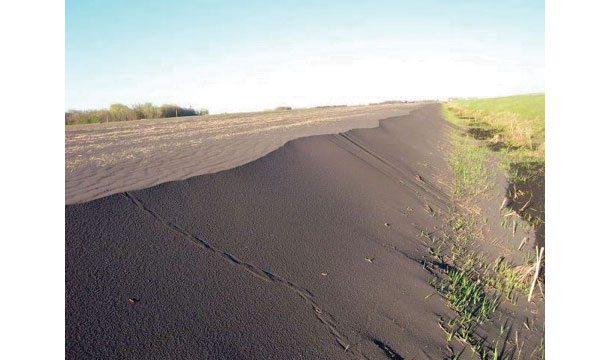
Why aren’t many farmers concerned about topsoil loss? Probably because the topsoil loss occurs less frequently than in the 1930s – and because the soil still looks black to them. In the 1960s, the Soil Conservation Service soil classifiers characterized many sites in North Dakota and identified depths to various soil layers.
Recently, North Dakota State University soil scientists revisited specific soils characterized for depth to subsurface horizons and found up to 19 inches of topsoil loss at one site in the past 50 years. The grower had no idea of the severity of loss.
Simultaneous erosion and tillage results in truncation of the soil horizon, as what is left of the dark topsoil is blended through tillage of the soil beneath. To the farmer, the soil still looks black. But it is not as black as it was.
Examination in soil pits of the organic matter that sifted more than 100 years ago into animal and worm burrows indicate the original organic matter levels in most North Dakota fields were much higher than today.
From examination of SCS and NRCS records of topsoil lost since 1940, a conservative estimate is that North Dakota has lost an additional 3 inches of topsoil on about 10 million acres. The fertilizer P2O5 and N contained in the lost soil is about 5 million tons of P2O5 and 16.5 million tons of N. This is equivalent to about 30 years of P and N application at present-day rates.
The answer to nearly eliminating soil loss from wind erosion is conversion to no-till, one-pass seeding and strip-tillage systems. The particulars in adopting these systems varies with soils and the farmer, but the results of their adoption are the same: improved soil capacity to resist drastic climate variation, greater productivity and profitability and improved soil characteristics that will make farming sustainable far into the future.
If North Dakota farms did not lose another pound of soil from their land, it would take another 70 years of P application at approximately double today’s average rate of application to approach the natural P levels on the land when they were first plowed. ![]()
References omitted but are available upon request. Click here to email an editor.
PHOTO 1: Buffalo bones delivered to the nearest collection depot for sell.
PHOTO 2: Buffalo bones delivered to the nearest collection depot for sell.
PHOTO 3: As soon as the prairie was plowed, the soil started to blow away.
PHOTO 4: In some years, the feilds were almost bare for months.
PHOTO 5: The movement of soil from the plains was astounding.
PHOTO 6: The USDA discovered that soils in the Great Plains were extremely erodible.
PHOTO 7: Many farmers think soil loss from wind erosion ends up in the road ditch.
PHOTO 8: North Dakota continues to lose topsoil up to the present day. Photos courtesy of Dave Franzen.

-
D.W. Franzen
- Extension Soil Specialist
- North Dakota State University
- Email D.W. Franzen









